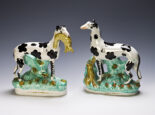Deep Roots

Burghley House is renowned as one of the largest and grandest Elizabethan houses in Britain. Conceived by William Cecil, Lord High Treasurer to Queen Elizabeth I, and built between 1555 and 1587, Burghley is a testament to the ambition and vision of the most powerful courtier of the first Elizabethan age. But Burghley’s most venerable residents are not people. They are not the statues, nor the house’s walls. They are trees. The Moment talked to Burghley’s Head Forester Peter Glassey about an incredible legacy dating back over 1,000 years.
Tell me what you’re responsible for at Burghley, and what it basically entails…
I have been Head Forester at Burghley since 1992, and my job is to look after all the trees within the Burghley estate, but with particular emphasis on the wonderful collection of trees we’ve got in Burghley Park. That’s a real focus of mine because Burghley Park has been landscaped by the foremost landscape designers of their respective ages. So we’ve got London and Cooke between 1690 and 1702, who set the park out in what’s called a patte d’oie design – literally ‘goose foot’ – a series of avenue plantings based on a continental fashion. The Fifth Earl and his wife Lady Anne Cavendish went on the Grand Tour, and were heavily influenced by the continental fashion of planting avenues or allées – tree-lined walkways – through the landscape, with the house as the central feature that these allées led to. They came back and engaged the services of George London and Moses Cooke of the Brompton Nurseries, who then laid out Burghley Park in a similar continental fashion. So, that’s the first major landscaping. The second is Lancelot Brown –‘Capability’ Brown – in 1756, just 50-60 years later, who ripped up all the avenues, with the exception of North Avenue and Queen Anne’s Avenue. He also did his wonderful work with the serpentine lake, and even ripped down the West Wing to bring the park right up to the house. So we’ve got this wonderful tree legacy. But prior to the that, we’ve got earlier features, which are the plantings of William Cecil and his son, Thomas, in the early 1600s, so many trees relate to that period as well. So we’ve really got three landscaping periods, William and Thomas Cecil, then London and Cooke, and then Lancelot Brown. And so we’ve got a fantastic collection of trees, and I’m always banging on about them!
 Clearly there’s a dramatic change with Capability Brown – but what does that mean in practical and stylistic terms?
Clearly there’s a dramatic change with Capability Brown – but what does that mean in practical and stylistic terms?
With London and Cooke you have the axial design of the patte d’oie, a series of very formal avenues radiating out from the central feature, which is the house. Brown’s approach involved ripping most of them out, retaining some to frame his ‘eyecatchers’ but also planting new groups of trees within an open sward to provide viewpoints and vistas more naturally throughout the landscape. He also took out The Great Pond and dug a 25 acre serpentine lake – his ‘New River’ – took away the West Wing of Burghley House, moved the entire stable block and orangery and built the Lion Bridge. This guy was a genius – and the Cecils must have had enormous faith in him to allow him to take down the West Wing! If I suggested anything like that, I think they’d think I was mad… This man obviously had incredible vision and knew what he wanted to achieve in a future he would never live to see. And it’s a much more naturalistic style than London and Cooke. When you walk through the park, if you stand still and look at some of the older trees you may think ‘Well, why are they there?’ Then you realise after a while that, actually, Brown left them there because he wants to direct your gaze to his eyecatchers – to the gates, or to the Lion Bridge. He’s focusing your eye very cleverly with the placements of trees he’s left from earlier generations, from the
times of William and Thomas Cecil. It’s very intuitive, what he’s designed, and you’ve got to really study it to see what’s going on. For instance, the Cedar of Lebanons around the lake. Cedar of Lebanon is one of his favourite trees to show you views of his eyecatchers, so wherever he’s planted Cedar of Lebanon, that’s a signpost tree. That’s the tree that he’s wanting you to look
at, to direct your gaze towards a particular view. But it’s done completely effortlessly. I find it very inspiring, that he was able to have that vision when these trees were so tiny. Burghley Park was actually his longest commission – he was here from 1756 to 1780 – so we’d like to think we’ve got the most complete example of a Capability Brown parkland.
People might perhaps have a general idea of what ‘forestry’ is, but what do you do on a day- to-day basis?
Really I would say I’m an arborist as well as a forester. Forestry is a discipline where you’re growing trees for timber, and we do have several woodlands which are what I would call forestry, mostly part of Capability Brown’s landscape design. But mine is more a cultural role where we are maintaining and looking after the veteran and ancient trees within the Burghley landscape. And my particular focus is trying to provide age succession, so I’ve been doing a lot of planting to try to conserve and preserve this legacy. We’ve got one tree in Burghley Park which is 800- 1,000 years old. It’s a wonderful old oak tree which precedes any of the building of Burghley. So, you have to think of a parkland tree as having a potential life of 1,000 years or more, and my role is to look after those trees and try to ensure that those trees will reach that potential – and in the meantime, planting the next age group to fill the landscape as the older ones leave us. I also sit on an expert panel of the Ancient Tree Forum, and we’re looking at what other people do, benchmarking us against other estates and other organisations, because we’re just starting to realise how important, ecologically – and not just in terms of landscape – these trees are. A mature oak tree over 500 years old, can support over 2,300 different forms of life. So, each tree in its own right is a sort of mini nature reserve, and Burghley Park is stuffed full of trees which either are 500 years old or
are approaching that age. So it’s a landscape legacy as well as an ecological legacy, which I take very seriously. There are inevitable conflicts with events, such as the horse trials, and working out how we keep the trees protected, and tackle issues of compaction and so on, but my main aim is to be able to hand over the trees in a fit condition to another person so they can continue to maintain this landscape.
 Is that a difficult balance to maintain?
Is that a difficult balance to maintain?
With the horse trials, we’re basically putting up a small village and taking it down again in six weeks. Within a historic landscape that has inevitable pressures – and the potential damage to trees is mainly soil related. A lot of people think a tree’s a tree and it just grows, but there’s a whole rhizosphere under the tree to maintain. These trees are interconnected with fungi, and if you start taking articulated lorries and heavy vehicles over these roots, it can kill the mycorrhizal fungi, and then the tree starts dying. So, you see a tree, but actually there’s a huge network underneath the ground that’s supporting that tree. And that’s what we need to maintain. It’s on the heavier clays or the integrated clay, with the oak trees in particular, where you notice the damage because the soil
is more plastic, and the anaerobic conditions become greater. That’s when you get the root death and the mycorrhizal fungi death. It is said that a tree without mycorrhizal fungi is a tree waiting to die. And these oak trees we are particularly wanting to keep, because they have the longevity to last another 400- 500 years. It’s really important we look after them. That’s the challenge. But everybody at Burghley is working together so we can have our cake and eat it – to design the event footprint so it’s not having an impact on the trees, and to maintain that wonderful tree backdrop. It’s a treescape, Burghley Park, and that’s why it’s such an attractive event venue.
This summer has seen high temperatures and drought, and there is climate change to deal with too. Do these present threats to the parkland?
If you look at the trees in the park, they’re all survivors, inevitably. They’ve been here for 500 years: they’ve seen droughts before, they’ve seen insect attack, they’ve seen winds and gales and storms. And so the very fact they’re still here shows they’re inherently of good genetic disposition. The English oak, Quercus robur, has a very big latitudinal range, so it’s one of the trees that’s going to cope quite well with climate change. And Brown and his forebears, being very good silviculturists, knew the ground intimately and planted the oak trees on the heavier soils. The sweet chestnuts we’ve got in the park have been planted on the soils which are sandier and freer draining, and they have survived. So, the tree species have been matched to site conditions by people who really knew their stuff. So as climate change ramps up, there’s hopefully an inherent resilience in the tree species that have been chosen. But I’m also experimenting with more exotic tree species. I’m planting a few Chinese mahoganies, Wollemi pines, cork oaks and shagbark hickories… These will hopefully provide a future treescape at Burghley with built-in resilience.
 All trees are unique and as they get older develop a character all their own, in ways that seem rather magical, like Tolkien’s Ents. Do you see them that way?
All trees are unique and as they get older develop a character all their own, in ways that seem rather magical, like Tolkien’s Ents. Do you see them that way?
Yes – and we’ve got some fantastical characters! The biggest one in the park is what I call ‘El Magnifico’, which is a sweet chestnut. It’s nine metres in girth at breast height, putting it within the top 25 largest trees in Great Britain and Ireland. We’ve got several sweet chestnuts around that size. We have some younger trees – London and Cooke trees from the 1690s, in front of Burghley House as you approach it – which were bombed in 1941 by a German pilot who jettisoned his bombs on the Park Road. They blew all the bark off these trees, but they’re still standing – so they’re survivors not just of the natural climate, but also of being bombed by the Luftwaffe! We also have an oak tree called ‘The Screaming Oak’, which looks like Munch’s Scream – it’s got this big, gaping bark wound on the trunk. We have another sweet chestnut, which was planted by one of the Cecils, which had a lot of the bark blown off by a lightning strike, and which looks like a dragon. Some stories are more recent. We are often approached by people who wish to remember loved ones by planting a commemorative tree in the park. So, there are a lot of old stories – the whole park is stuffed full of history – but there are always new ones too, and I’m very focused on trying to make sure that we’re looking after the trees in the landscape for future generations. So, we’re trying to build resilience, not just by looking after the trees we’ve got, but actually with the placement of new trees within the landscape, and making sure that they are matched to the particular soil conditions of the site. I put two Wollemi pines in an area of the park called Jubilee Wood, and they are just growing at a phenomenal rate. Because – by sheer fluke, I think – I’ve chosen the correct site for these trees! But they are huge now, and to see them growing away is just wonderful. That gives me a lot of satisfaction that, yes, we’ve got this wonderful legacy from previous generations, but we’re trying to add resilience for the future as well, with all the challenges we face with climate change.
Most of these trees will outlive us all, and many more generations to come. Do you have the sense that you’re just passing through?
That’s what foresters do. We don’t see what we plant. We are just passing through, just trying to put them there for the future, and I get a huge amount of satisfaction out of seeing young trees I put in growing and filling the landscape. But the most important thing about all this, I think, is the continuity of ownership of these historic estates. The continuity of ownership of the Cecils has provided us with this gem. Outside the park it’s very much a denuded landscape, and a lot of the veteran, ancient trees within the landscape have been cut down and ploughed over, hundreds of years ago. Within the park they had the power to say ‘No, this is ours…’ And thank goodness they did, because we’re now left with these gems throughout the British countryside, holding these incredible ecological, landscaped treasures for people to enjoy. And it’s so important. So, the Burghley House Preservation Trust’s objectives are to look after not just the house, but also the parkland and the trees, and all the monies that come in help to keep that going.
 This may be a silly question, but how many trees are we talking about in total?
This may be a silly question, but how many trees are we talking about in total?
There are between 1,200 and 1,300 acres of parkland, and we’ve got about 3,500 trees in total. But that doesn’t include the avenue trees. That’s just the open sward trees. We have ten oak trees which are over five metres in circumference at breast height. Then we have the several trees which are on the Tree Register of Britain and Ireland as being champion or heritage trees. We have El Magnifico, the really big one, which is in the top 25 largest trees in Great Britain and Ireland. So the whole park is stuffed full of really incredible, ancient, veteran, notable trees. And long may they continue! There’s just an incredible array of shapes and sizes, all trees which have adapted to their site, grown in a particular way, been hammered by the natural elements – by wind, by storms, by lightning – that have left us with this wonderful legacy we have now. I do regular park tree tours so people can come and have a look and hear about some of these wonderful characters.















